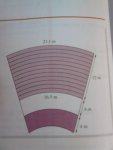We are doing arithmetic progression (series) at the moment and this is a task that was among the all others, so I guess it has got something to do with arithmetic series. Anyway, the situation is the following:

Also, there is one more parameter, the width of a seat which is 55 cm.
Questions/tasks are:
1. Of how many rows does auditorium consist?
2. How many seats does the first row have, and how many the last?
3. How many seats are there in other rows?
4. What is the total number of seats in auditorium?
5. What is the surface are of the theatre?
1. I guess this could be read from the picture. So, there are 12 rows.
2. What I did here is : number of seats in the first row \(\displaystyle \dfrac{16.5 \cdot 100}{55}=30\, seats \) number of seats in the last row \(\displaystyle \dfrac{23.1 \cdot 100}{55}=42\, seats \)
3. I don't know how to solve this. Since these seats should be organised by some arithmetic series I guess, then :
\(\displaystyle a_n=a_1+(n-1)d \\ if\, a_n=42\, a_1=30\, n=12\, (auditorium\, consists\, of\, 12\, rows) \, 42=30+11d \, d=\dfrac{12}{11} \)
That means that every next row has \(\displaystyle \dfrac{12}{11} \) seats more than the previous. But then again, how could a number of seats be other than integer. You don't have 0.5 seats, so I don't understand what should be done here. What's the problem.
4. I would be able do solve this using the formula for the sum of a arithmetic series if the previous task was correct.
5. What I did here is : \(\displaystyle r_1\, (radius\, of\, the\, circle\, on\, which\, the\, first\, curve\, is)\, r_2\, (radius\, of\, the\, last\, row-\, from\, the\, center\, of\, all\, curves\, to\, the\, last\, row)\, l=\dfrac{r\pi\alpha}{180}\, (length\, of\, a\, circle\, arc) \\ \dfrac{l_1}{l_2}=\dfrac{\dfrac{r_1\pi\alpha}{180}}{\dfrac{r_2\pi\alpha}{180}} \, \, r_2=r_1+20m \\ \dfrac{16.5}{23.1}=\dfrac{r_1}{r_1+20} \\ r_1=50m \, \, r_2=70m \\ l_1=\dfrac{r_1\pi\alpha}{180} \, \, \alpha=\dfrac{180l_1}{r_1\pi}\, \, \alpha=18.9076^{°} \\ P_{theatre}=\dfrac{(r_2^{2}-r_1^{2})\pi\alpha}{360} P_{theatre}=395.999 \dotso m^2 \\ P_{theatre}\approx 396m^2\)
I would appreciate it if someone would put me on the right path.

Also, there is one more parameter, the width of a seat which is 55 cm.
Questions/tasks are:
1. Of how many rows does auditorium consist?
2. How many seats does the first row have, and how many the last?
3. How many seats are there in other rows?
4. What is the total number of seats in auditorium?
5. What is the surface are of the theatre?
1. I guess this could be read from the picture. So, there are 12 rows.
2. What I did here is : number of seats in the first row \(\displaystyle \dfrac{16.5 \cdot 100}{55}=30\, seats \) number of seats in the last row \(\displaystyle \dfrac{23.1 \cdot 100}{55}=42\, seats \)
3. I don't know how to solve this. Since these seats should be organised by some arithmetic series I guess, then :
\(\displaystyle a_n=a_1+(n-1)d \\ if\, a_n=42\, a_1=30\, n=12\, (auditorium\, consists\, of\, 12\, rows) \, 42=30+11d \, d=\dfrac{12}{11} \)
That means that every next row has \(\displaystyle \dfrac{12}{11} \) seats more than the previous. But then again, how could a number of seats be other than integer. You don't have 0.5 seats, so I don't understand what should be done here. What's the problem.
4. I would be able do solve this using the formula for the sum of a arithmetic series if the previous task was correct.
5. What I did here is : \(\displaystyle r_1\, (radius\, of\, the\, circle\, on\, which\, the\, first\, curve\, is)\, r_2\, (radius\, of\, the\, last\, row-\, from\, the\, center\, of\, all\, curves\, to\, the\, last\, row)\, l=\dfrac{r\pi\alpha}{180}\, (length\, of\, a\, circle\, arc) \\ \dfrac{l_1}{l_2}=\dfrac{\dfrac{r_1\pi\alpha}{180}}{\dfrac{r_2\pi\alpha}{180}} \, \, r_2=r_1+20m \\ \dfrac{16.5}{23.1}=\dfrac{r_1}{r_1+20} \\ r_1=50m \, \, r_2=70m \\ l_1=\dfrac{r_1\pi\alpha}{180} \, \, \alpha=\dfrac{180l_1}{r_1\pi}\, \, \alpha=18.9076^{°} \\ P_{theatre}=\dfrac{(r_2^{2}-r_1^{2})\pi\alpha}{360} P_{theatre}=395.999 \dotso m^2 \\ P_{theatre}\approx 396m^2\)
I would appreciate it if someone would put me on the right path.
Attachments
Last edited:

